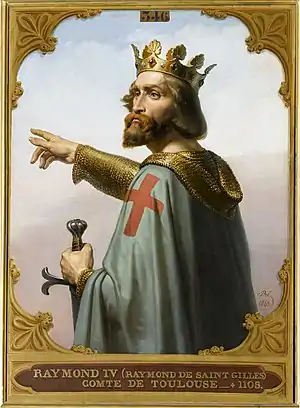1094
Year 1094 (MXCIV) was a common year starting on Sunday (link will display the full calendar) of the Julian calendar.
| Millennium: | 2nd millennium |
|---|---|
| Centuries: | |
| Decades: | |
| Years: |
| 1094 by topic |
|---|
| Leaders |
|
| Birth and death categories |
| Births – Deaths |
| Establishments and disestablishments categories |
| Establishments – Disestablishments |
| Gregorian calendar | 1094 MXCIV |
| Ab urbe condita | 1847 |
| Armenian calendar | 543 ԹՎ ՇԽԳ |
| Assyrian calendar | 5844 |
| Balinese saka calendar | 1015–1016 |
| Bengali calendar | 501 |
| Berber calendar | 2044 |
| English Regnal year | 7 Will. 2 – 8 Will. 2 |
| Buddhist calendar | 1638 |
| Burmese calendar | 456 |
| Byzantine calendar | 6602–6603 |
| Chinese calendar | 癸酉年 (Water Rooster) 3790 or 3730 — to — 甲戌年 (Wood Dog) 3791 or 3731 |
| Coptic calendar | 810–811 |
| Discordian calendar | 2260 |
| Ethiopian calendar | 1086–1087 |
| Hebrew calendar | 4854–4855 |
| Hindu calendars | |
| - Vikram Samvat | 1150–1151 |
| - Shaka Samvat | 1015–1016 |
| - Kali Yuga | 4194–4195 |
| Holocene calendar | 11094 |
| Igbo calendar | 94–95 |
| Iranian calendar | 472–473 |
| Islamic calendar | 486–487 |
| Japanese calendar | Kanji 8 / Kahō 1 (嘉保元年) |
| Javanese calendar | 998–999 |
| Julian calendar | 1094 MXCIV |
| Korean calendar | 3427 |
| Minguo calendar | 818 before ROC 民前818年 |
| Nanakshahi calendar | −374 |
| Seleucid era | 1405/1406 AG |
| Thai solar calendar | 1636–1637 |
| Tibetan calendar | 阴水鸡年 (female Water-Rooster) 1220 or 839 or 67 — to — 阳木狗年 (male Wood-Dog) 1221 or 840 or 68 |

Portrait of Raymond IV (c. 1041–1105)
Events
Byzantine Empire
- Spring – Emperor Alexios I (Komnenos) sends a Byzantine expeditionary force under General Tatikios to Nicaea, in an attempt to re-capture the city from the Seljuk Turks. However, the arrival of Barkiyaruq's army en route stops the Byzantines. Alexios sends reinforcements; short of supplies, the Seljuk Turks retreat. Abu'l-Qasim, Seljuk governor of Nicaea, is defeated and forced to conclude a truce with Alexios.[1]
Europe
- May – Rodrigo Diaz de Vivar (El Cid) completes his conquest of Valencia in Al-Andalus (modern Spain). He begins his rule (in the name of King Alfonso VI) of Valencia. The Almoravid campaign to regain the city fails.[2]
- July 28 – William Bertrand dies, and his margravial title of Provence is inherited by Raymond IV (Saint-Gilles), who becomes count of Toulouse (until 1105).
Scotland
- May – Duncan II (son of the late King Malcolm III) invades England at the head of an army of Norman knights from Scotland, aided by his half-brother Edmund. He succeeds his uncle, King Donald III (the Fair), as ruler of Scotland.[3]
- November 12 – King Donald III mobilizes his army and kills Duncan II in battle in the Lowlands. He re-takes the Scottish throne, Edmund sides with Donald as co-ruler and is named as heir as he has no children.
Seljuk Empire
- Sultan Mahmud I dies after a 2-year reign. He is succeeded by his brother Barkiyaruq (one of the Seljuk prince who claim the throne) as ruler of the Seljuk Empire.
Births
- January 14 – Eudokia Komnene, Byzantine princess (d. 1129)
- Abd al-Mu'min, Almohad caliph (approximate date)
- Ibn Zuhr (or Avenzoar), Moorish physician (d. 1162)
- Malachy, Irish archbishop and saint (d. 1148)
- Richard d'Avranches, 2nd Earl of Chester (d. 1120)
- Yelü Dashi, founder of the Qara Khitai (d. 1143)
Deaths
- January 10 – Al-Mustansir Billah, Fatimid caliph (b. 1029)
- February 3
- June 2 – Nicholas the Pilgrim, Italian shepherd (b. 1075)
- June 4 – Sancho V, king of Aragon and Pamplona
- July 28 – William Bertrand, margrave of Provence
- October 14
- November 12 – Duncan II, king of Scotland
- Abu Ali Fana-Khusrau, Buyid nobleman
- Al-Bakri, Moorish historian and geographer
- Aq Sunqur al-Hajib, Seljuk sultan of Aleppo
- Badr al-Jamali, Fatimid vizier and statesman
- Isaac Albalia, Andalusian Jewish astronomer (b. 1035)
- Jonathan I, Italo-Norman count of Carinola
- Mahmud I, sultan of the Seljuk Empire
- Michael of Avranches, Italian bishop
- Roger de Beaumont, Norman nobleman
- Roger de Montgomery, Norman nobleman
- Terken Khatun, Seljuk empress and regent
- William Fitzeustace, Norman nobleman
- Wulfnoth Godwinson, English nobleman
References
- Timothy Venning (2015). A Chronology of the Crusades, p. 24. ISBN 978-1-138-80269-8.
- Picard C. (1997). La mer et les musulmans d'Occident au Moyen Age. Paris: Presses Universitaires de France.
- Potter, Philip J. (2009). Gothic Kings of Britain: The Lives of 31 Medieval Rulers (1016–1399), pp. 127–128. Jefferson, North Carolina: McFarland. ISBN 978-0-7864-4038-2.
This article is issued from Wikipedia. The text is licensed under Creative Commons - Attribution - Sharealike. Additional terms may apply for the media files.